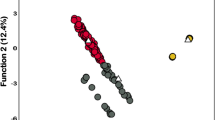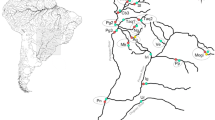Abstract
Detection of hybridization and introgression in wild populations that have been supplemented by hatchery fish is necessary during development of conservation and management strategies. Initially, allozyme data and more recently highly polymorphic microsatellite markers have been used to obtain this information. We used both markers to assess the effectiveness of four assignment methods (Structure, NewHybrids, Baps and GeneClass) to detect hatchery introgression in wild stocked populations. Simulations of hybrid genotypes from real parental data revealed that the number and type of markers used with Structure, NewHybrids and Baps can identify as admixed most first and second generation hybrids as well as first generation backcrosses. In wild populations, introgression rates estimated from different markers and methods were correlated. However, slight disagreements were observed at both population and individual levels. Overall, the fully Bayesian (Structure, NewHybrids and Baps) performed better than partially Bayesian (GeneClass) assignment tests. In wild collections, Baps analyses were limited because of the lack of a native baseline. In all cases, the efficiency of methods was reduced as introgression increased.


Similar content being viewed by others
References
Allendorf FW, Leary RF, Hitt NP, Knudsen KL, Lundguist LL, Spruell P (2004) Intercrosses and the U.S. endangered species act: should hybridrised populations be included as westslope cutthroat trout? Conserv Biol 18:1203–1213
Anderson EC, Thompson EA (2002) A model-based method for identifying species hybrids using multilocus genetic data. Genetics 160:1217–1229
Araguas RM, Sanz N, Pla C, García-Marín JL (2004) Breakdown of the brown trout evolutionary history due to hybridization between native and cultivated fish. J Fish Biol 65:28–37
Arias J, Sánchez L, Martínez P (1995) Low stocking incidence in brown trout populations from north-western Spain monitored by LDH-5* diagnostic marker. J Fish Biol 47:170–176
Aurelle D, Cattaneo-Berrebi G, Berrebi PL (2002) Natural and artificial secondary contact in brown trout (Salmo trutta L.) in the French western Pyrenees assessed by allozymes and microsatellites. Heredity 89:171–183
Barilani M, Deregnaucourt S, Gallego S, Galli L, Mucci N, Piombo R, Puigcerver M, Rimondi S, Rodríguez-Teijeiro JD, Spanò S, Randi E (2005) Detecting hibridization in wild (Coturnix c. coturnix) and domesticated (Coturnix c. japonica) quail populations. Biol Conserv 126:445–455
Barilani M, Sfougaris A, Giannakopoulos A, Mucci N, Tabarroni C, Randi E (2007) Detecting introgressive hybridization in rock partridge populations (Alectoris graeca) in Greece through Bayesian admixture analyses of multilocus genotypes. Conserv Genet 8:343–354
Berry O, Tocher MD, Sarre SD (2004) Can assignment tests measure dispersal? Mol Ecol 13:551–561
Brown C, Day RL (2002) The future of stock enhancements: lessons for hatchery practice from conservation biology. Fish Fish 3:79–94
Cairney M, Taggart JB, Høyheim B (2000) Characterization of microsatellite and minisatellite loci in Atlantic salmon (Salmo salar L.) and cross-species amplification in other salmonids. Mol Ecol 9:2155–2234
Corander J, Marttinen P (2006) Bayesian identification of admixture events using multilocus molecular markers. Mol Ecol 15:2833–2843
Corujo M, Blanco G, Vázquez E, Sánchez JA (2004) Genetic structure of northwestern Spanish brown trout (Salmo trutta L.) populations, differences between microsatellite and allozyme loci. Hereditas 141:258–271
Cortey M, Pla C, García-Marín JL (2004) Historical biogeography of Mediterranean trout. Mol Phylogenet Evol 33:831–844
Cowx IG (1999) An appraisal of stocking strategies in the light of developing country constraints. Fish Manag Ecol 6:21–34
Estoup A, Presa P, Krieg F, Vaiman D, Guyomard R (1993) (CT)n and (GT)n microsatellites: a new class of genetic markers for Salmo trutta L. (brown trout). Heredity 71:488–496
Estoup A, Largiader CR, Perrot E, Chourrout D (1996) Rapid one-tube DNA extraction for reliable PCR detection of fish polymorphic markers and transgenes. Mol Mar Biol Biotechnol 5:295–298
Frankham R, Ballou JD, Briscoe DA (2002) Introduction to conservation genetics. Cambridge University Press, UK
Ferguson M, Taggart JB, Prodohl PA, McMeel O, Thompson C, Stone C, McGinnity P, Hynes RA (1995) The application of molecular markers to the study and conservation of fish populations, with special reference to Salmo. J Fish Biol 47:103–126
García-Marín JL, Jorde PE, Ryman N, Utter F, Pla C (1991) Management implications of genetic differentiation between native and hatchery populations of brown trout (Salmo trutta) in Spain. Aquaculture 95:235–249
García-Marín JL, Sanz N, Pla C (1998) Proportions of native and introduced Brown trout in adjacent fished and unfished Spanish Rivers. Conserv Biol 12:313–319
Garnier S, Alibert P, Audiot P, Prieur B, Rasplus JY (2004) Isolation by distance and sharp discontinuities in gene frequencies: implications for the phylogeographyy of an alpine insect species, Carabus solieri. Mol Ecol 13:1883–1897
Gharbi K, Gautier A, Danzmann RG, Gharbi S, Sakamoto T, Hoyheim B, Taggart JB, Cairney M, Powell R, Krieg F, Okamoto N, Ferguson MM, Holm LE, Guyomard R (2006) A linkage map for brown trout (Salmo trutta): chromosome homeologies and comparative genome organization with other salmonid fish. Genetics 172:2405–2419
Goudet J (1995) Fstat version 1.2: a computer program to calculate Fstatistics. J Hered 86:485–486
Hansen MM, Kenchington E, Nielsen EE (2001a) Assigning individuals fish to populations using microsatellite DNA markers. Fish Fish 2:93–112
Hansen MM, Nielsen EE, Bekkevold D, Mensberg KLD (2001b) Admixture analysis and stocking impact assessment in brown trout (Salmo trutta), estimated with incomplete baseline data. Can J Fish Aquat Sci 58:1853–1860
Hauser L, Seamons TR, Dauer M, Naish KA, Quinn TP (2006) An empirical verification of population assignment methods by marking and parentage data: hatchery and wild steelhead (Oncorhynchus mykiss) in Forks Creek, Washington, USA. Mol Ecol 15:3157–3173
Hewitt G (2001) Speciation, hybrid zones and phylogeography—or seeing genes in space and time. Mol Ecol 10:537–549
Koskinen MT, Hirvonen H, Landry PA, Primmer CR (2004) The benefits of increasing the number of microsatellites utilized in genetic populations studies: an empirical perspective. Hereditas 141:61–67
Latch EK, Dharmarajan G, Glaubitz JC, Rhodes OE Jr (2006) Relative performance of Bayesian clustering software for inferring population substructure and individual assignment at low levels of population differentiation. Conserv Genet 7:295–302
Lerceteau-Kohler E, Weiss S (2006) Development of a multiplex PCR microsatellite assay in brown trout Salmo trutta, and its potential application for the genus. Aquaculture 258:641–645
Manel S, Berthier P, Luikart G (2002) Detecting wildlife poaching: identifying the origin of individuals with Bayesian assignment tests and multilocus genotypes. Conserv Biol 16:650–659
McMeel OM, Hoey EM, Ferguson A (2001) Partial nucleotide sequences, and routine typing by polymerase chain reaction-restriction fragment length polymorphism, of the brown trout (Salmo trutta) lactate dehydrogenase, LDH-C1*90 and *100 alleles. Mol Ecol 10:29–34
Nielsen EE, Bach LA, Kotlicki P (2006) Hybridlab (version 1.0): a program for generating simulated hybrids from population samples. Mol Ecol Notes 6:971–973
O’Reilly PT, Hamilton LC, McConnell SK, Wright JM (1996) Rapid analysis of genetic variation in Atlantic salmon (Salmo salar) by PCR multiplexing of dinucleotids and tetranucleotide microsatellites. Can J Fish Aquat Sci 53:2292–2298
Paetkau D, Slade R, Burden M, Estoup A (2004) Genetic assignment methods for the direct, real-time estimation of migration rate: a simulation-based exploration of accuracy and power. Mol Ecol 13:55–65
Paterson S, Piertney SB, Knox D, Gilbey J, Verspoor E (2004) Characterization and PCR multiplexing of novel highly variable tetranucleotide Atlantic salmon (Salmo salar L.) microsatellites. Mol Ecol Notes 4:160–162
Piry S, Alapetite A, Cornuet JM, Paetkau D, Baudouin L, Estoup A (2004) GeneClass2: a software for genetic assignment and first-generation migrant detection. J Hered 95:536–539
Poteaux C, Berrebi P, Bonhomme J (2001) Allozymes, mtDNA and microsatellites study introgression in a stocked trout population in France. Rev Fish Biol Fisher 10:281–292
Presa P, Guyomard R (1996) Conservation of microsatellites in three species of salmonids. J Fish Biol 49:1326–1329
Pritchard JK, Stephens M, Donnelly P (2000) Inference of population structure using multilocus genotype data. Genetics 155:945–959
Rannala B, Mountain JL (1997) Detecting immigration by using multilocus genotypes. Proc Natl Acad Sci USA 94:9197–9201
Raymond M, Rousset F (1995) Genepop (ver. 3.3): a population genetics software for exact test and ecumenicism. J Hered 86:248–249
Rhymer JM, Simberloff D (1996) Extinction by hybridization and introgression. Annu Rev Ecol Syst 27:83–109
Slettan A, Olsaker I, Lie Ø (1995) Atlantic salmon, Salmo salar, microsatellites at the SSOSL25, SSOSL85, SSOSL311, SSOSL417 loci. Anim Genet 26:281–282
Slettan A, Olsaker I, Lie Ø (1996) Polymorphic Atlantic salmon (Salmo salar L.) microsatellites at the SSOSL438, SSOSL439 and SSOSL444 loci. Anim Genet 27:57–58
Vähä JP, Primmer CR (2006) Efficiency of model-based Bayesian methods for detecting hybrid individuals under different hybridization scenarios and with different numbers of loci. Mol Ecol 15:63–72
Ward RD, Woodwark M, Skibinski DOF (1994) A comparison of genetic diversity levels in marine, fresh-water, and anadromous fishes. J Fish Biol 44:213–232
Acknowledgements
This research meets the objectives of the REN-2003–05931/GLO project of the Spanish MCYT. R. Fernandez and M. Vera were fellows of the Spanish MCYT. We thank FM Utter for English revision and for valuable suggestions to improve this manuscript.
Author information
Authors and Affiliations
Corresponding author
Rights and permissions
About this article
Cite this article
Sanz, N., Araguas, R.M., Fernández, R. et al. Efficiency of markers and methods for detecting hybrids and introgression in stocked populations. Conserv Genet 10, 225–236 (2009). https://doi.org/10.1007/s10592-008-9550-0
Received:
Accepted:
Published:
Issue Date:
DOI: https://doi.org/10.1007/s10592-008-9550-0




